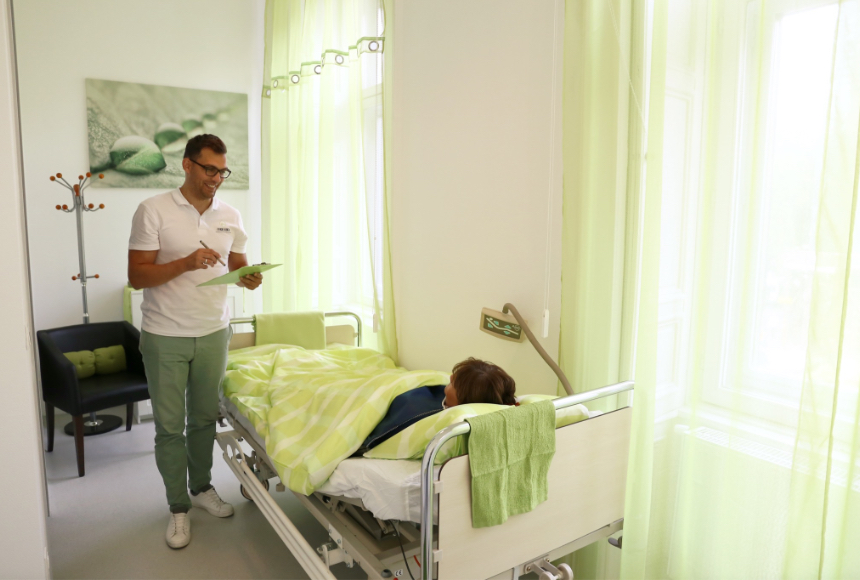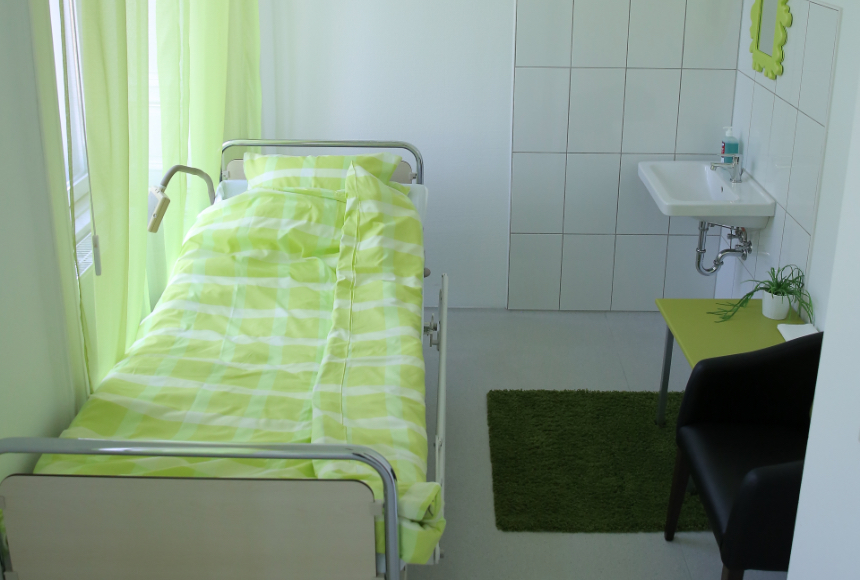FOR ANXIETY PATIENTS
We are specialized in the treatment of anxiety patients, so we often meet patients who have not been in a dental practice for a long time due to their fear of the dentist. Consequences of dental fear can be neglected or bad teeth. This fear of dental treatment typically has its causes in one or more of the following experiences:
- fear of pain that one has experienced
- An unfriendly or rude dentist
- Insufficient information before the dental treatment
- Anatomical problems, such as gagging or hypersensitivity
- Sensitivity to odours or sounds
At Evergreen Dental, we have a great deal of experience with anxiety patients and are well-prepared, so we help with our very kind team to overcome these fears. The most modern techniques we use ensure painless treatment, and our dentists are very sensitive and careful and have a very fine approach.
HOW DOES GENERAL ANESTHESIA TAKE PLACE?
GENERAL ANESTHESIA STEP BY STEP
1. PREPARATION
In the preparatory phase, an anamnesis sheet is first filled out to reveal possible contraindications for the treatment team. For most patients, a laboratory (blood) test is required in advance, and some require an ECG scan and a chest x-ray, so that the doctors have all the important data at their disposal. Thereafter, the dental treatment under general anaesthesia can be planned. The treatments are always scheduled for the morning, the patient must not eat or drink from midnight on of the previous day, so it makes sense to schedule the general anaesthetic treatment for the morning.
2. ARRIVAL
Upon arrival, the patient will live in the recovery room, where he/she will be able to recover from the treatment afterwards. The patient changes into a surgical gown before treatment, removes jewellery or watch and puts the valuables in a safe. Also contact lenses, prostheses, hearing aids as well as nail polish must be removed.
3. BEGINNING OF THE TREATMENT
After a brief consultation with the anaesthetist, the treatment begins. Starting with securing venous, so the necessary medicine can be brought in.
4. BREATHING SAFETY
Throughout the treatment, the airways are protected by intubation through the nose. This allows the dentist to work without problems in the patient’s mouth.
5. DENTAL TREATMENT
During dental treatment, the anaesthetist will monitor all vital signs on the monitor. As needed, sleep aids, analgesics and antibiotics are given. The following values are constantly monitored by the anaesthetist:
- ECG
- Blood pressure control
- Saturation measurement
- Breathing output measurement for carbon dioxide and other gases
6. FINISHING OF DENTAL TREATMENT
At the end, the feeding of soporifics is stopped, the patient is extubated, thus the respiratory tract is uncovered, the patient awakes within a short time.
7. DIRECTLY AFTER TREATMENT
The patient is escorted to the recovery room, where he/she can calmly recover from the treatment until he/she returns to his/her old strength. The patient is supervised and looked after by a specialist nurse all the time. Regularly, one can leave the clinic after 2-3 hours.
8. AGAIN IN THE HOTEL
The patient is never left alone by us. Once the condition of the patient is back to normal, he/she is taken by our driver to the hotel, where he/she can rest. The reception of our partner hotels is always informed if the patient has received a dental treatment under general anaesthesia and special attention is paid. On the day of general anaesthesia you should not start the journey home, the day after you can leave without any problems.
WHICH DENTAL TREATMENTS CAN BE MADE UNDER GENERAL ANESTHESIA?
Basically any dental treatment can be performed under general anaesthesia. It makes the dental treatment very comfortable for both the patient and the dentist, and we can work very efficiently and often do much more at once than without general anaesthesia.
The typical dental treatments under general anaesthesia at Evergreen Dental are the following:
- Major surgical procedures, such as tooth removal, bone augmentation and implants.
- The combination of different surgical procedures, e.g. tooth removal, bone augmentation and/or implants are made at the same time.
- Large aesthetic dental procedures, e.g. many teeth are burred at once.
- All other treatments, e.g. removal of wisdom teeth if the patient has special fear of the dentist.
MUST THERE BE AN ACCOMPANYING PERSON?
At Evergreen Dental, a qualified nurse is available to care for the patient after dental treatment under general anaesthesia so that no companion needs to be arranged by the patient.
WHY IS GENERAL ANESTHESIA SAFER THAN INSULATED SLEEP?
By securing the airways, general anaesthesia is completely safe. In contrast to sedation or half-sleep where the sedative is given by intubation, which complicates a simultaneous work in the mouth and also the protection of the respiratory tract cannot be granted permanently.
WHICH ADVANTAGES DOES GENERAL ANESTHESIA HAVE?
General anaesthesia has the absolute advantage of convenient, painless, efficient dental treatment without problems, such as gagging or any bad experience. In addition, a very extensive dental treatment can often be carried out at once, which otherwise can only be done in several steps, and that can save a lot of time. For example, it may be possible to do a dental treatment consisting of tooth removal, bone augmentation, and implants in one instead of three sessions. This can even save up to 9 months of treatment time.

WHAT PREPARATIONS DOES IT NEED BEFORE TREATMENT UNDER GENERAL ANESTHESIA? PREPARATION STEP BY STEP:
- First, an anamnesis sheet is filled out, from which important findings can be obtained, also with regard to general anaesthesia.
- Next, the treatment plan will be finalized based on the preliminary examination. The steps that can be taken in general anaesthesia will be identified.
- Prior to dental treatment under general anaesthesia, most patients must undergo a blood test in the laboratory. This is done by the general practitioner. Alternatively we can arrange the blood test in Budapest however in this case two additional days have to be spent in Budapest prior to the treatment. Patients with a maximum of 40 years, with a negative history, do not need a laboratory or any other examinations. In case of patients of advanced age, we also require an ECG scan and a chest X-ray.
- The results must be sent in advance to the medical team for evaluation. The laboratory examination should be carried out no more than two weeks before the scheduled dental treatment under general anaesthesia.
- Do not eat or drink 6 hours before the general anaesthesia, even water and chewing gum are not allowed. If you have to take medication in that time, you can drink the maximum 0.1 litres of water with it.
WHAT DOES GENERAL ANESTHESIA COST?
The general anaesthesia is billed per hour. You can find the cost in pur pricelist on our website. The price includes the tariff for the anaesthetist, anaesthesia assistance, medicine use, recovery room use, specialist nurse.
WHOM DO WE RECOMMEND TREATMENT UNDER GENERAL ANESTHESIA?
First and foremost, we recommend treatment under general anaesthesia in case of major surgical interventions, when, for example, six implants are placed at once and possibly also bone or sinus lift is done.
Likewise, we recommend anxious patients dental treatment under general anaesthesia or due to anatomic causes, such as severe gagging.
WHAT SHOULD BE KEPT IN MIND BEFORE AND AFTER GENERAL ANESTHESIA?
If the values are correct, it is most important not to eat or drink before treatment as complications may occur. Definitely not eat 6 hours before the anaesthetic treatment; drinking should be avoided at least three hours before the anaesthetic treatment. If medications are taken, then these must be taken based on prior consultation. Unauthorized you should never give up taking the medication. The timing of eating and drinking after treatment is always discussed individually with the patient because it depends on the procedure.
After the general anaesthesia, you can do everything as normal again. As soon as you have completely recovered, you have to leave the clinic with an accompanying person who is provided by Evergreen Dental. You are not allowed to leave home on the same day, you are not allowed to drive for 24 hours or resume work in a dangerous environment.
WHO MAKES THE GENERAL ANESTHESIA?
The permission to perform general anaesthesia treatments is subject to very strict regulations. General anaesthesia can only be performed by a qualified anaesthetist who must always be accompanied by an anaesthetic assistant.
Evergreen Dental works exclusively together with the chief anaesthetist of the Military Hospital of Budapest, Dr. med. Béla Szabó. He has over 30 years experience as an anaesthetist and is available to Evergreen Dental patients every Tuesday and Thursday.

IS GENERAL ANESTHESIA DANGEROUS? WHAT ARE THE RISKS?
In rare cases, complications may occur in the form of unknown medical sensitivity. In even rarer cases enzyme deficiency, in extreme cases malignant hyperthermia, overheating of the body may occur. For such cases, we have the necessary aid and background institutes, so in an emergency we can take the patient to a hospital.
The risks of a particular procedure can be very diverse, depending on the personal circumstances of the patient. The intervening anaesthetist or surgeon can individually explain the risks then the patient can responsibly decide whether he/she desires treatment under general anaesthesia.
CAN YOU DIE DURING TREATMENT UNDER GENERAL ANESTHESIA?
Details are not known about this question, but there are the following numerical facts:
In case that the patient is healthy, has no concomitant disease such as high blood pressure, heart disease or similar illness and it is no life-saving surgery, the fatal outcome is extremely rare. Thereby the exact statistical value is unknown, but based on estimates one case per 100,000 operations is assumed.
In the case of an ambulant treatment like dental treatment, so if the patient can leave the clinic after a few hours, the risk is even lower. In this case the anaesthetist has rated the patient as suitable for general anaesthetic treatment, then basically the patient is healthy and dentistry is not considered to be a major surgery.
For pre-planned, smaller operations, including dental surgery, the risk of fatal outcome or permanent brain damage associated with general anaesthesia is extremely low. These risks increase when the patient is at a very advanced age, has a serious co-morbid illness and when emergency surgery is performed, but even in these cases these risks are very minimal. More than 90% of deaths from surgery can in no way be associated with general anaesthesia.
Source:
The Royal College of Anaesthetists
Revised Edition 2009
www.rcoa.ac.uk
standards@rcoa.ac.uk

WHAT SEDATIVES/MEDICATIONS ARE USED UNDER GENERAL ANESTHESIA?
Propofol, nitrogen oxides, Sevoflurane and possibly analgesics such as Voltaren (Diclofenac), Paracetamol (Acetaminophen) or Iboprofen are used.
ARE THERE VARIOUS DEPTHS OF GENERAL ANESTHESIA?
Yes, but we only use general anaesthesia with airway protection by intubation, either intravenously or with inhalation technique.
IS GENERAL ANESTHESIA POSSIBLE DURING PREGNANCY?
Yes, but only in acute cases. In the case of a planned tooth or germ surgery, treatment under general anaesthesia is therefore not possible because of the risk.
WHAT ARE THE EXCLUSION CRITERIA FOR DENTAL TREATMENT UNDER GENERAL ANESTHESIA?
General anaesthesia itself has no exclusion criteria, but in ambulant treatment, certain patients are excluded according to our proficiency protocols. These are untreated or unchecked diseases of
- heart disease
- lung disease
- kidney failure
- mental illness
- liver diseases
